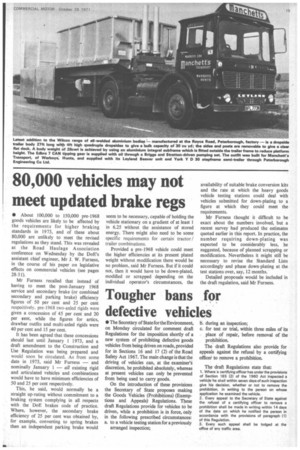80,000 vehicles may not meet updated brake regs
Page 17

If you've noticed an error in this article please click here to report it so we can fix it.
• About 100,000 to 150.000 pre-1968 goods vehicles are likely to be affected by the requirements for higher braking standards in 1973, and of these about 80.000 are unlikely to meet the revised regulations as they stand. This was revealed at the Road Haulage Association conference on Wednesday by the DoE's assistant chief engineer, Mr J. W. Furness, in the course of his paper on legislative effects on commercial vehicles (see pages 28.31).
Mr Furness recalled that instead of having to meet the post-January 1968 service and secondary brake (or combined secondary and parking brake) efficiency figures of 50 per cent and 25 per cent respectively. pre-196F1 two-axled rigids were given a concession of 45 per cent and 20 per cent, while the figures for artics, drawbar outfits and multi-axled rigids were 40 per cent and 15 per cent.
It has been agreed that these concessions should last until January 1 1973, and a draft amendment to the Construction and Use Regulation was being prepared and would soon be circulated. As from some date in 1973. said Mr Furness — and nominally January 1 — all existing rigid and articulated vehicles and combinations would have to have minimum efficiencies of 50 and 25 per cent respectively.
This, he said, would normally be a straight up-rating without commitment to a braking system complying in all respects with the DoE brakes code of practice. Where, however, the secondary brake efficiency of 25 per cent was obtained by, for example. converting to spring brakes then an independent parking brake would seem to be necessary, capable of holding the vehicle stationary on a gradient of at least 1 in 6.25 without the assistance of stored energy. There might also need to be some specific requirements for certain tractor / trailer combinations.
Provided a pre-1968 vehicle could meet the higher efficiencies at its present plated weight without modification there would be no problem. said Mr Furness. But if it could not, then it would have to be down-plated, modified or scrapped depending on the individual operator's circumstances, the availability of suitable brake conversion kits and the rate at which the heavy goods vehicle testing stations could deal with vehicles submitted for down-plating to a figure at which they could meet the requirements.
Mr Furness thought it difficult to be exact about the numbers involved, but a recent survey had produced the estimates quoted earlier in this report. In practice, the number requiring down-plating was expected to be considerably less, he suggested, because of planned scrapping or modification. Nevertheless it might still be necessary to revise the Standard Lists accordingly and phase down plating at the test stations over, say, 12 months.
Detailed proposals would be included in the draft regulation, said Mr Furness.












































































































































